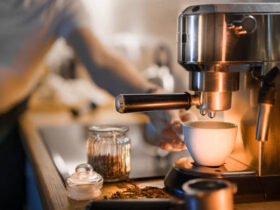Coffee. It’s more than just a morning ritual; it’s a daily indulgence that awakens our senses and fuels our ambitions. Whether you’re an avid coffee connoisseur or someone who simply enjoys a good cup to start your day, understanding the quality of coffee beans is key to elevating your coffee experience. But with the myriad of options on the market, how do you sift through the noise to find the best coffee beans that suit your palate?
In this comprehensive guide, we’ll explore the world of coffee beans. From understanding different types and origins to tips on selecting the perfect roast, you’ll gain insights that will transform your coffee routine into a delightful adventure. Discover the nuances that make certain coffee beans stand out and learn how to brew a cup that resonates with your taste buds. Let’s dive into the aromatic world of coffee and uncover the secrets behind the best coffee beans.
The Origin of Coffee Beans
The story of coffee begins its voyage in the lush landscapes of Ethiopia, where legend has it that a goat herder discovered the energizing effects of coffee berries. Fast forward several centuries, and these humble beans have become a global phenomenon, deeply embedded in cultures worldwide. Understanding the origin of your coffee beans is crucial because it significantly impacts the flavor profile of your brew.
Coffee beans are broadly categorized into three main regions: Africa, Latin America, and Asia-Pacific. African beans, particularly those from Ethiopia and Kenya, are celebrated for their bright acidity and floral notes. Latin American coffees, such as those from Colombia and Brazil, offer a balanced taste with nutty and chocolatey undertones. Meanwhile, Asia-Pacific beans, like those from Sumatra, present bold, earthy flavors with lower acidity.
Each region’s unique climate, soil, and altitude contribute to the distinct characteristics found in the beans. By familiarizing yourself with these origins, you can better understand and appreciate the flavor profiles that each region offers, enabling you to make more informed choices in your coffee selection.
Types of Coffee Beans
When it comes to coffee, not all beans are created equal. In fact, there are four main types of coffee beans, each offering their own unique flavors and qualities. The most popular and widely consumed is Arabica, which accounts for about 60% of the world’s coffee production. Arabica beans are known for their smooth, mild flavor and slightly acidic undertones, making them a favorite among coffee enthusiasts.
Next up is Robusta, a bean favored for its strong, bold taste and higher caffeine content. Robusta beans are often used in espresso blends and instant coffee due to their robust flavor profile. Although less popular than Arabica, Robusta is appreciated by those who prefer a more intense coffee experience.
The other two types, Liberica and Excelsa, are less common but still worth exploring. Liberica beans offer a unique fruity and floral aroma, while Excelsa contributes a tart, fruity flavor often used to enhance blends. Understanding the differences between these bean types is essential for selecting the perfect coffee to match your taste preferences.
Understanding Coffee Roasts
Ah, the art of roasting—a critical factor in bringing out the rich flavors and aromas in coffee beans. Roasting transforms the raw, green coffee bean into the aromatic, dark brown bean we’re familiar with. But not all roasts are the same, and each offers a distinct taste experience.
Light roasts are characterized by a light brown color and minimal oil on the surface of the bean. They tend to preserve the beans’ natural flavors and are often described as having a brighter, more acidic taste. Medium roasts, on the other hand, offer a balance between flavor, acidity, and aroma, providing a fuller body without overpowering the coffee’s inherent characteristics.
For those who crave a bolder, richer flavor, dark roasts are the way to go. These beans are dark brown, almost black, with a shiny, oily surface. Dark roasts have a pronounced bitterness and are often used in espresso blends. By understanding the differences in roast levels, you can select the perfect roast to complement your preferred coffee taste.
How to Choose the Best Coffee Beans
Selecting the best coffee beans is a personal and subjective process, but there are a few key factors to consider to ensure you make a great choice. First and foremost, consider the flavor profile you desire. Do you enjoy a bright, fruity coffee with high acidity, or do you prefer a rich, bold cup with deep chocolate notes?
Next, pay attention to the freshness of the beans. Coffee is best enjoyed fresh, so look for beans with a roast date rather than an expiration date. Additionally, consider the grind size you need for your preferred brewing method. For example, coarse grinds are ideal for French press, while finer grinds are suited for espresso machines.
Lastly, consider the ethical and environmental impact of your coffee choice. Look for beans certified as Fair Trade, Organic, or Rainforest Alliance to ensure your coffee is produced sustainably and ethically. By taking these factors into account, you can confidently choose the best coffee beans to enhance your coffee experience.
Brewing Techniques for Maximum Flavor
Once you’ve selected your beans, the next step is mastering the brewing process to extract the maximum flavor from your coffee. There are various brewing methods to choose from, each offering a unique taste experience.
The French press, for example, is known for producing a full-bodied, rich cup of coffee. It involves steeping coarsely ground beans in hot water before pressing the grounds with a metal or plastic plunger. This method captures the oils and flavors that other brewing techniques might miss, resulting in a robust brew.
For those who prefer a smooth, clean cup, pour-over and Chemex methods are excellent choices. These methods involve pouring hot water over coffee grounds in a filter, allowing the water to slowly drip through into a carafe. This technique highlights the beans’ nuanced flavors and aromas, creating a delicate yet flavorful cup.
If you’re a fan of bold, intense coffee, an espresso machine is the way to go. Espresso brewing involves forcing hot water through finely ground coffee under high pressure, resulting in a concentrated shot with a rich crema. Perfect for lattes, cappuccinos, and other espresso-based drinks.
Storing Coffee Beans for Optimal Freshness
Proper storage is essential to maintaining the freshness and flavor of your coffee beans. Exposure to air, moisture, heat, and light can all degrade the quality of your beans, so it’s important to store them correctly.
The best way to store coffee beans is in an airtight container, away from direct sunlight and heat sources. Choose a cool, dark place, such as a pantry or cupboard, to keep your beans fresh.
Avoid storing coffee beans in the refrigerator or freezer, as fluctuating temperatures can cause condensation, leading to stale flavors. Additionally, coffee beans can absorb odors from other foods, affecting their taste.
By storing your coffee beans properly, you can preserve their freshness and enjoy a delicious cup every time.
The Role of Grind Size in Coffee Extraction
Grind size plays a crucial role in the extraction process and directly impacts the flavor of your coffee. Different brewing methods require different grind sizes to achieve optimal extraction.
For instance, a coarse grind is ideal for French press brewing, as it allows for a slower extraction, resulting in a full-bodied cup. On the other hand, a medium grind is suitable for drip coffee makers and pour-over methods, providing a balanced extraction with a clean finish.
Espresso machines require a fine grind, as the high pressure and short brewing time necessitate a quick extraction. Using the correct grind size ensures that your coffee is neither over-extracted nor under-extracted, resulting in a perfectly balanced cup.
Exploring Single-Origin vs. Blended Coffee
When choosing coffee beans, you’ll often encounter the terms “single-origin” and “blended.” Understanding the difference between these two can help you make an informed decision about your coffee preferences.
Single-origin coffee is sourced from a specific region or country, offering a distinct flavor profile that reflects the unique characteristics of its origin. These coffees are ideal for those who appreciate the nuances of a particular region’s beans and want to explore the diversity of flavors available.
Blended coffee, on the other hand, combines beans from multiple regions to create a harmonious flavor profile. Blends are often designed to achieve a consistent taste, making them popular for espresso drinks and regular drip coffee.
Choosing between single-origin and blended coffee ultimately depends on your taste preferences and willingness to explore different flavor profiles.
Ethical and Sustainable Coffee Practices
In recent years, there has been a growing focus on ethical and sustainable coffee practices, as consumers become more conscious of the social and environmental impact of their purchases. By choosing coffee beans certified as Fair Trade, Organic, or Rainforest Alliance, you can support sustainable farming practices and ensure fair wages and working conditions for farmers.
Fair Trade certification guarantees that farmers receive a fair price for their coffee, promoting economic stability and community development. Organic certification ensures that the coffee is grown without harmful chemicals, protecting the environment and promoting biodiversity.
Rainforest Alliance certification focuses on preserving ecosystems and wildlife, as well as improving the livelihoods of coffee farmers. By choosing ethically sourced coffee beans, you can enjoy your brew while supporting positive change in the industry.
Enhancing Your Coffee Experience
To truly elevate your coffee experience, consider investing in quality equipment and experimenting with different brewing methods. A good grinder, for instance, allows you to adjust grind size for different brewing techniques, ensuring optimal extraction and flavor.
Additionally, try exploring various brewing methods, such as Aeropress, cold brew, or siphon brewing, to discover new flavors and textures. By experimenting with different techniques, you can find the perfect combination that suits your taste preferences.
Remember, the key to a great coffee experience lies in the details—from bean selection and grind size to brewing method and equipment. By paying attention to these factors, you can unlock the full potential of your coffee beans and enjoy a consistently delicious cup.
FAQs
Q1. What are the best coffee beans for beginners?
A1. For beginners, we recommend starting with a medium roast Arabica bean. These beans offer a balance of flavor and acidity, making them approachable for new coffee enthusiasts.
Q2. How do I know if my coffee beans are fresh?
A2. Fresh coffee beans typically have a strong aroma and a shiny, oily surface. Check for a roast date on the packaging, and aim to consume your beans within 2-4 weeks of roasting for optimal flavor.
Q3. Can I store coffee beans in the freezer?
A3. While it’s not ideal, you can store coffee beans in the freezer if absolutely necessary. Use an airtight container and only remove what you need to minimize temperature fluctuations and condensation.
Conclusion
Understanding the best coffee beans can greatly enhance your coffee experience. By exploring different origins, bean types, and roast levels, you can discover the perfect coffee to suit your taste preferences. Remember to consider ethical and sustainable practices when choosing your beans, and don’t be afraid to experiment with different brewing methods and equipment. With a little knowledge and exploration, you can transform your daily coffee routine into a delightful adventure.
Ready to take your coffee experience to the next level? Start by exploring your local coffee shops or online retailers to find the best beans for your taste preferences. Happy brewing!





